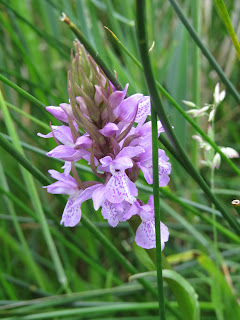 |
| Azure Damselfly (I think) |
Its Friday and boy, what a lovely day! I have returned to Strumpshaw for the afternoon for another attempt in finding three of the four insects that are still on my challenge list. With the willow emerald damselfly still yet to emerge, my attention is mainly on the common blue butterfly, the hornet and the water scorpion. These three species should be out now and the fact that I have yet to find and photograph them is a bit embarrassing. They shouldn't be this difficult to find, but for some reason, they have been avoiding me.
 |
| Meadow Brown with Bumblebee |
First up, a walk down the Sandy Wall path for common blues and hornets. The bird's-foot trefoil is still out and the brambles and other shrubs are now in bloom, plenty of nectar sources for these two targets to chose from. However, I could not find either of them. Meadow brown butterflies were out in force this afternoon and there were even a few large skippers and brimstones as well as the odd small tortoiseshell and red admiral, but no sign of the common blue! As for the hornet, I had a few people coming up to me and telling me that they've just seen one just moments ago! Not fair!
 |
| Large Skipper |
 |
| Hoverfly of some kind |
 |
| Another Hoverfly |
 |
| Red-tipped Clearwing |
One of these people was Ben the Strumpshaw warden. He was busy surveying the reserve's insects when I met him today. He was after clearwing moths, dayflying moths that resemble sawflies or wasps. To survey them, he had put up some bait in a bag (mainly scent-producing plants that these moths can't resist) and hang it up on a branch. They were soon drawn to it, well, like a moth to a flame and Ben had his net at the ready to sweep them out of the air. Apparently, I had just missed him catching a white-barred clearwing, which, according to Ben, is the first on record for this part of Norfolk (the Yare Valley)! I may have missed out on Ben's catch of the day, but the bait was still working its magic and more clearwings were being lured to it. This time, they were red-tipped clearwings. I have never seen a clearwing before, so I was happy in seeing this far more commoner species than no clearwing at all.
 |
| Red-eyed Damselfly |
At the river end of the Sandy Wall path is a jetty. Peering down from this jetty, lily pads were just about floating above the surface as the water level in the river was high after the extremely heavy downpour from last night. As I stare down at the lily pads, I soon found a personal favourite of mine, the red-eyed damselfly. Though not a target for my challenge, I couldn't resist seeing them as I think there's nothing better than to see them hop from pad to pad with a quick pose to show you how pretty they are in the sunshine of a warm, lazy, summer's day. If only Monet included them into his paintings of lily pads.
 |
| Black-tailed Skimmer |
 |
| Stickleback |
With no luck with the common blues and hornets, I did a spot of pond dipping to try and catch a water scorpion. Despite sweeping the pond for several minutes, I could only find a few water boatmen, caddisfly larvae, a stickleback (I think) and other tiny pond creatures. No water scorpion. I feel like I need a group of children to find me one. Children are good at finding water scorpions and they are far more energetic than me. They could probably pond dip for hours if they wanted to.
 |
| Water Boatman |
 |
| Brimstone |
After failing with the water scorpion, I made one more walk along Sandy Wall, but still no common blue or hornet. So I then decided to check the meadow trail for them. The meadow trail was a bit boggy to walk along. You really need proper walking boots or a pair of wellies here as the path was waterlogged in places and very muddy. Still, these were great conditions for the orchids and the entire meadow was full of them. Wherever you look, several of them were poking out of the grass with red, pink, purple or white flowers. Each ranged in various heights and number of florets that each possessed. It is hard to tell if they are different species or if they are just hybrids of the same species without an orchid expert on hand, but if I had to guess, I would say that they were mostly southern marsh orchids. I couldn't find the hornets or common blues or even the marsh helleborines that were supposedly here. To end my afternoon, I saw a hobby in a tree from Reception Hide, while a shrew was scurrying between the benches inside the hide.
 |
| Small Tortoiseshell |
 |
| A Moth that I have no idea what it is |
 |
| Four-spot Chaser |
 |
| Southern Marsh Orchid |
 |
| Orchids in the meadow |
 |
| Red Admiral |
 |
| Hobby |





































No comments:
Post a Comment